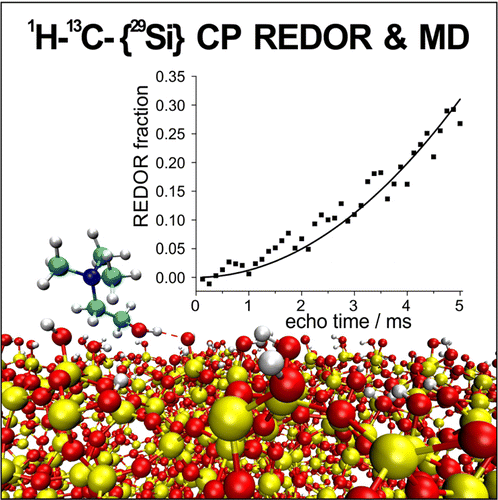Understanding the molecular interactions between inorganic phases such as silica and organic material is fundamental for chromatographic applications, for tailoring silica enzyme interactions, and for elucidating the mechanisms of biomineralization. The formation, structure, and properties of the organic/inorganic interface is crucial in this context. Here, we investigate the interaction of selectively C-13-labeled choline with Si-29-labeled monosilicic acid/silica at the molecular level. Silica/choline nanocomposites were analyzed by solid-state NMR spectroscopy in combination with extended molecular dynamics (MD) simulations to understand the silica/organic interface. Cross polarization magic angle spinning (CP MAS)-based NMR experiments like H-1-C-13 CP-REDOR (rotational-echo double resonance), H-1-C-13 HETCOR (heteronuclear correlation), and H-1-Si-29-H-1 double CP are employed to determine spatial parameters. The measurement of Si-29-C-13 internuclear distances for selectively C-13-labeled choline provides an experimental parameter that allows the direct verification of MD simulations. Atomistic modeling using classical MD methodologies is performed using the INTERFACE force field. The modeling results are in excellent agreement with the experimental data and reveal the relevant molecular conformations as well as the nature and interplay of the interactions between the choline cation and the silica surface. Electrostatic interactions and hydrogen bonding are both important and depend strongly on the hydration level as well as the charge state of the silica surface.

Understanding the molecular interactions between inorganic phases such as silica and organic material is fundamental for chromatographic applications, for tailoring silica enzyme interactions, and for elucidating the mechanisms of biomineralization. The formation, structure, and properties of the organic/inorganic interface is crucial in this context. Here, we investigate the interaction of selectively C-13-labeled choline with Si-29-labeled monosilicic acid/silica at the molecular level. Silica/choline nanocomposites were analyzed by solid-state NMR spectroscopy in combination with extended molecular dynamics (MD) simulations to understand the silica/organic interface. Cross polarization magic angle spinning (CP MAS)-based NMR experiments like H-1-C-13 CP-REDOR (rotational-echo double resonance), H-1-C-13 HETCOR (heteronuclear correlation), and H-1-Si-29-H-1 double CP are employed to determine spatial parameters. The measurement of Si-29-C-13 internuclear distances for selectively C-13-labeled choline provides an experimental parameter that allows the direct verification of MD simulations. Atomistic modeling using classical MD methodologies is performed using the INTERFACE force field. The modeling results are in excellent agreement with the experimental data and reveal the relevant molecular conformations as well as the nature and interplay of the interactions between the choline cation and the silica surface. Electrostatic interactions and hydrogen bonding are both important and depend strongly on the hydration level as well as the charge state of the silica surface.
